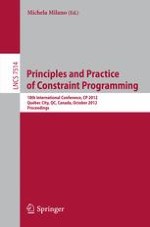This book constitutes the thoroughly refereed post-conference proceedings of the 18th International Conference on Principles and Practice of Constraint Programming (CP 2012), held in Québec, Canada, in October 2012. The 68 revised full papers were carefully selected from 186 submissions. Beside the technical program, the conference featured two special tracks. The former was the traditional application track, which focused on industrial and academic uses of constraint technology and its comparison and integration with other optimization techniques (MIP, local search, SAT, etc.) The second track, featured for the first time in 2012, concentrated on multidisciplinary papers: cross-cutting methodology and challenging applications collecting papers that link CP technology with other techniques like machine learning, data mining, game theory, simulation, knowledge compilation, visualization, control theory, and robotics. In addition, the track focused on challenging application fields with a high social impact such as CP for life sciences, sustainability, energy efficiency, web, social sciences, finance, and verification.
